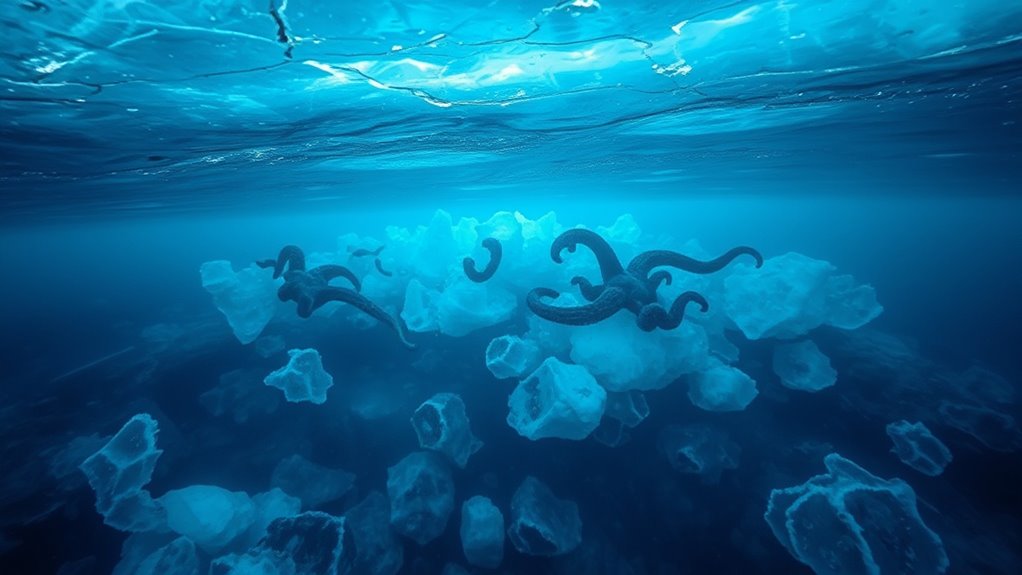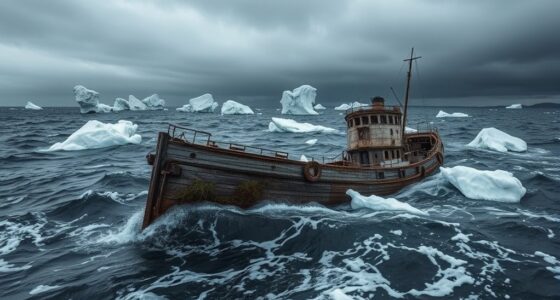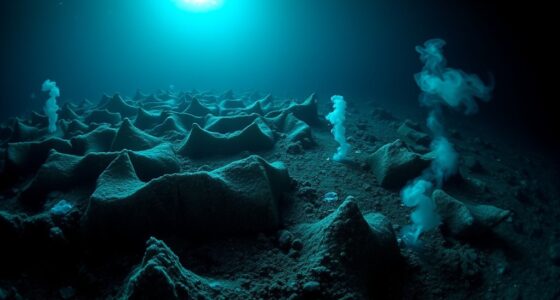Beneath more than 4 kilometers of Antarctic ice, Lake Vostok holds a hidden, resilient ecosystem of microbial life that has survived in total isolation for millions of years. These microbes have adapted to extreme conditions like high pressure, darkness, and cold temperatures, using chemosynthesis to get energy and recycle nutrients. Their survival shows how life can endure in environments once thought uninhabitable. Continue exploring to discover more about this extraordinary underground world.
Key Takeaways
- Lake Vostok is a massive subglacial lake buried under approximately 4 km of Antarctic ice.
- Its isolated ecosystem hosts diverse microbes adapted to extreme pressure, cold, and darkness.
- Microorganisms survive through chemosynthesis and nutrient recycling, supporting a stable ecosystem.
- The ecosystem’s resilience illustrates life’s ability to persist in extreme, uninhabited environments.
- Studying Lake Vostok offers insights into potential extraterrestrial life and resilience in harsh habitats.

Beneath the thick ice sheets of Antarctica lies Lake Vostok, one of the largest subglacial lakes on Earth, and it hides a mysterious ecosystem untouched for millions of years. As you explore this hidden world, you realize that the microbial diversity within the lake is astonishing. Despite the extreme conditions—pressure, darkness, and cold—the lake teems with microorganisms that have adapted in remarkable ways. These microbes form the foundation of the ecosystem, carrying out processes that sustain life beneath the ice. Their diversity hints at complex interactions and survival strategies that have persisted in isolation, undisturbed by surface changes or human activity.
Hidden beneath Antarctica’s ice, Lake Vostok hosts a resilient microbial ecosystem thriving in extreme, isolated conditions.
This microbial community isn’t just diverse; it’s resilient. You see that ecosystem resilience here is tested by the extreme environment, yet these organisms have developed robust mechanisms to withstand the absence of sunlight, limited nutrients, and freezing temperatures. Some microbes are capable of chemosynthesis, converting inorganic compounds into energy, while others recycle nutrients efficiently to sustain their populations. This resilience isn’t accidental; it’s a testament to evolutionary pressures that have shaped life in one of Earth’s most inhospitable places. You observe how this resilience helps maintain the stability of the entire ecosystem, allowing it to survive in isolation for millions of years.
As you explore more deeply, you understand that the microbial diversity contributes directly to the ecosystem’s resilience. Different species fill various ecological roles—some break down organic material, others fix carbon or nitrogen, and a few may even form symbiotic relationships. This interconnected web of microbial life ensures that nutrient cycles continue smoothly, even in the absence of external inputs. Microbial diversity plays a crucial role in supporting the ecosystem’s stability and adaptability. The resilience of this ecosystem isn’t just about survival; it’s about persistence and adaptation, showcasing nature’s ability to thrive in the most unlikely conditions.
Studying Lake Vostok’s microbial diversity and ecosystem resilience offers insights beyond Antarctica. It challenges your assumptions about life’s limits and highlights the importance of microbial communities in sustaining ecosystems under extreme conditions. These microbes demonstrate that life can endure in environments once thought uninhabitable, expanding your understanding of biological resilience. The lake’s hidden ecosystem is a natural laboratory, revealing how life persists in the face of adversity and inspiring new questions about resilience, adaptation, and the potential for life elsewhere in the universe.
Frequently Asked Questions
How Do Scientists Access Lake Vostok Safely?
To access Lake Vostok safely, scientists use a sterile, hot-water drilling system to prevent contamination of subglacial microbial communities. They carefully plan to avoid disrupting ice sheet dynamics and guarantee the environment remains pristine. This method allows them to penetrate the ice sheet without introducing external microbes, preserving the lake’s unique ecosystem while enabling research into its hidden microbial life beneath 4 km of ice.
What Technologies Are Used to Study the Lake Remotely?
You explore remote sensing technologies like satellites and aerial imaging to study hidden environments without direct contact. Autonomous vehicles, such as underwater drones or ice-penetrating probes, help gather data from beneath thick ice layers safely. These tools allow you to monitor temperature, chemical composition, and other essential signs remotely, providing critical insights without risking contamination or damage to fragile ecosystems or sensitive data collection points.
Could Lake Vostok Support Extraterrestrial Life?
You might wonder if Lake Vostok’s extreme environment could support extraterrestrial life. Its isolated, cold, and dark conditions make it an alien analog, similar to what you might find on icy moons like Europa. Studying this hidden ecosystem helps you understand how life adapts to extreme environments, offering clues about potential extraterrestrial habitats. If life persists here, it suggests that similar conditions elsewhere might also harbor life.
How Long Has Lake Vostok Been Isolated?
Imagine time standing still, as Lake Vostok has been isolated for about 15 to 25 million years. This ancient microbial life persists in extreme conditions, surviving despite climate change effects that once melted and refrozen the ice. You realize this extraordinary longevity offers clues about life’s resilience, hinting that even in Earth’s harshest environments, life endures in hidden depths, echoing stories from a distant, untouched past.
What Are the Potential Impacts of Drilling Into the Lake?
When you drill into an untouched lake like Vostok, you face significant environmental risks, such as contaminating the pristine ecosystem. You need to implement strict contamination prevention measures to protect the unique microbial life and prevent external pollutants from entering. If not carefully managed, drilling could irreversibly harm the ecosystem, making it essential to plan thoroughly and use advanced protocols to minimize ecological damage and preserve this hidden environment.
Conclusion
You’ve just learned that Lake Vostok is buried under 4 kilometers of ice, creating a unique, isolated ecosystem. Imagine this: despite such extreme conditions, scientists estimate there are thousands of microbial life forms thriving beneath the ice. This hidden world proves that life can exist in the most unexpected places, challenging what we understand about habitability. It’s a fascinating reminder of nature’s resilience and the incredible diversity lurking beneath the frozen surface.









